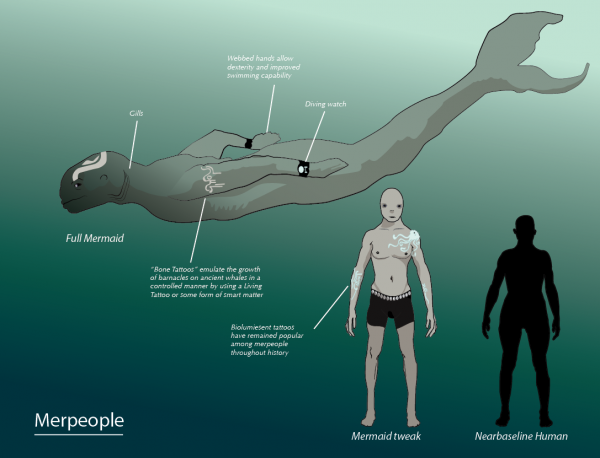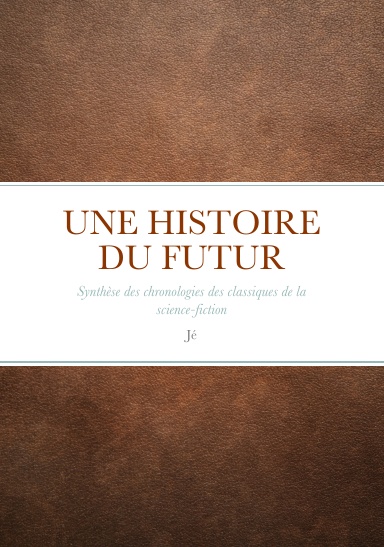
Image from Arik
| |
| The earliest clades of merpeople were aquatic air-breathers, and could hold their breath for up to ten minutes and dive more than 100 metres deep. True water-breathers such as the Europans were not developed until several centuries later. | |
The tweaks known as Homo aquaticus were the first true-breeding artificial species of human to become established during the Interplanetary Age. Several other species of aquatic human have been developed since that time, some more radically altered than others.
Development of the Merpeople
By the start of the 22nd century c.e., attitudes to genetic engineering and advanced technology were changing rapidly, A small but growing population of superbright humans with enhanced genomes was working together with the newly developed artificially intelligent computer systems (known as superturings) to repair widespread ecological degradation. This had been caused by the ill considered use of technology, fossil fuels and industrialised food production, and also by sporadic but environmentally damaging warfare during the previous hundred and fifty years. Particularly badly hit were the enclosed waters of the Mediterranean sea, which after decades of pollution and eutrophication were in large part barren and devoid of life.The project to restore the living ecosystem of the Mediterranean, MedRec S.A., was headed by a young superbright Nikolaus Vassiliou, with the assistance of the superturing AI NiarchosII and a team of augmented marine biologists. The devastated waters were soon filled with remote drone submarines and underwater survey teams, including biochipped dolphins (there were as yet no geneered neodolphins) and seals. The difficulties of working in the murky depths led the team to explore new possibilities. Vassiliou was a keen follower of genetic research into the evolution of marine mammals, and was informed by contacts within the bioengineering megacorp IntronTEK (soon after renamed GeneTEK) that mapping and extrapolation of various gene complexes had produced a number of possibly viable genotypes for marine humans. These extrapolations were based on cetacean and pinniped analogues, and sounded ideal for the sort of underwater ecological management his group was engaged in. The plans to gestate the new genotypes at a secret location off the coast of Australia were encountering scientific and political problems, and the MedRec group decided to purchase the virtual genotypes for their own assessment.
At first the new genotypes had a high failure rate but a small number of viable individuals were born in artificial wombs in Valleta, EU, between 2130 and 2135 c.e. (161 to 166 a.t.). The viable individuals were not unveiled to the public until 175 a.t., although rumours had been circulating on the net for years. Because of the radical design of this first new human species, now formally named Homo Aquaticus, there was a great deal of shock and indignation amongst the religious community, and the Campaign for Human Purity was formed to lobby for the arrest of Vassilou and the prevention of further abominations. A clever use of memetics and spin by the superbrights and AI involved, and the winsome appeal of the young merpeople, managed to win over a large part of the population of the EU, who were by this time broadly tolerant of gene therapy and familiar with genetically enhanced chimpanzees and other pets.
The Merpeople in the Solar System.
In the following centuries the Merpeople maintained an uneasy alliance with the surface dwellers. They were feted by Hollywood and the big entertainment megacorps like Inscape and Universes Unlimited, idealised by many green, ecologist, and hippie feral groups, despised and feared by the Ludds and certain fundamentalist Christian factions (in 281 a.t. the Reverend Josh Harrel, head of the militant anti-tweak and anti-AI church Christian Redemption, called them "the wicked result of godless man's attempt at playing God"), and manipulated for political propaganda purposes by various governments and megacorps. At any rate, it is doubtful that their population ever exceeded half a million.The first Merpeople were aquatic airbreathers, like dolphins, with comparable swimming and diving skills, but were not able to breathe underwater. The first clade capable of breathing under water was the Cishp, from Titan, which emerged during the Nanotech age.
In the sixth century, Jovian Genetics & Adaptation developed a similar species, capable of surviving deep under the ice on Europa, a large moon of Jupiter. This clade was lost for many centuries, and only rediscovered during the First Federation era.
In 390, a Baseline Supremist hate group known as the Homo Sapiens Front released a gengineered virus especially designed to target merpeople. Hundreds died before an antidote could be gengineered by GeneTEK and what was left of UNESCO. It is not known what happened to the original H.S.F. but they apparentlydisappeared rather mysteriously about the same time.
During the Nanotech Window of the early 6th century, when many of the impoverished baselines were trying make a break for the stars, it is known that several mergroups, seeking to escape from the interference and harassment of the surface dwellers, also launched ships - the SeaHorse, the Poseidon, and several others. It is not known what became of most of them; nine out of ten of the ships launched at this time never made it to their destination, some became Haloist, and of the remainder half are still in transit, travelling at sub-relativistic velocities to various corners of the universe.
The plagues and nanotech swarms and all the associated destruction that hit Earth several decades later spared neither merpeople nor surface dwellers, it is not (and probably never will be) known how many perished before the AI known as GAIA emerged and erected a shield of Blue Goo that saved the Terran biosphere.
During the Great Expulsion of the 7th century, GAIA allowed the surviving merpeople to remain on Earth, along with a small population of land-dwelling nearbaselines, rianths, and splices.
Because of present restrictions on travel to Earth it is not known how many Merpeople remain on the planet, if indeed any still do. The Earth Rianths, the Ecologists, and the Priestesshood of Gaia rigidly control all outgoing information, and access is limited because of the defense systems GAIA has erected, and the rather trigger-happy valkyries She employs to take out curious freelance journalists and adventurers who try to land on Earth without permission.
Later History of the Merpeople
During the First Federation, the original merpeople species was confined to the resticted Earth. However a small group of merpeople was allowed by GAIA to visit the nearby system of Tau Ceti, via the newly constructed Einstein Gate, at the invitation of King Stanley III, in 2491. The oceanographic institute of the Kingdom of Eyre decided to secretly replicate the genome of their visitors, assisted by genetic samples taken from the water in the accommodation they were allocated. From this small beginning a new species Homo Novaquaticus was developed, and a new diaspora of merpeople occurred, as the Novan merpeople were free to emigrate and join the exploration of the galaxy.A major settlement of merpeople can be found at Zennor system in Libra, where several clades of merpeople have developed on the worlds of Lamorna, Sennen and Gweek, including the huge whale-like Megaptera species and the Zennorian mermen, famous for their impressive appearance and a common sight at ceremonial aquatic displays throughout the Terragen sphere.

Image from Steve Bowers
|


















1 commentaire:
Einstein Bridge
Wormhole linking Sol System and Tau Ceti. It is the oldest macroscopic wormhole still in operation and, apart from a period during the Version War when it was shut down, it has been in continuous operation since the middle Expansion Age.
Enregistrer un commentaire